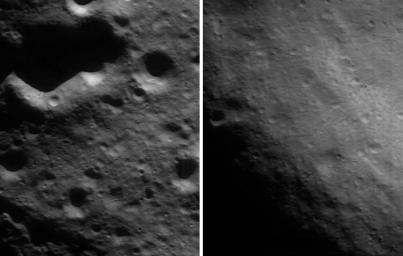
|
The Signs of the Times
- Click the image above for a larger view
- Full-Res JPEG (750 x 477) (40.2 kB)
- Full-Res TIFF (750 x 477) (279.4 kB)
Caption:
NEAR Shoemaker's investigation of Eros from low altitude orbit continues to bring the asteroid's history into sharper focus. This pair of images, taken April 18, 2000, from an orbital height of 99 kilometers (61 miles), shows the dissimilarity of two different regions of the asteroid. The left panel shows a region typical of Eros, whereas the right panel shows the inside of the saddle. As the images show, the saddle region has far fewer craters.
Craters are formed by the explosive impacts of asteroid fragments that have rained onto the surface over the eons. A freshly exposed surface will have fewer craters than a surface exposed to space for a longer time. The lesser number of craters in the saddle shows that it has been wiped clean, or "resurfaced," by geologic processes relatively late in Eros' history.
Background Info:
Built and managed by The Johns Hopkins University Applied Physics Laboratory, Laurel, Maryland, NEAR was the first spacecraft launched in NASA's Discovery Program of low-cost, small-scale planetary missions. See the NEAR web page at http://near.jhuapl.edu/ for more details.
Cataloging Keywords:
| Name | Value | Additional Values |
|---|---|---|
| Target | 433 Eros | |
| System | Near Earth Objects | |
| Target Type | Asteroid | |
| Mission | NEAR Shoemaker | |
| Instrument Host | NEAR Shoemaker | |
| Host Type | Orbiter | |
| Instrument | Multi-Spectral Imager (MSI) | |
| Detector | ||
| Extra Keywords | Crater, Grayscale, Impact | |
| Acquisition Date | ||
| Release Date | 2000-06-10 | |
| Date in Caption | 2000-04-18 | |
| Image Credit | NASA/JPL/JHUAPL | |
| Source | photojournal.jpl.nasa.gov/catalog/PIA02902 | |
| Identifier | PIA02902 | |
